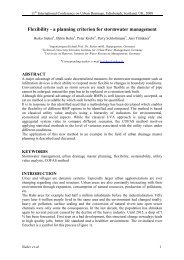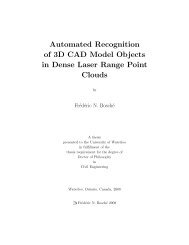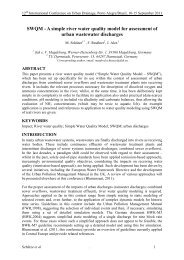ACME 2011 Proceedings of the 19 UK National Conference of the ...
ACME 2011 Proceedings of the 19 UK National Conference of the ...
ACME 2011 Proceedings of the 19 UK National Conference of the ...
Create successful ePaper yourself
Turn your PDF publications into a flip-book with our unique Google optimized e-Paper software.
2 MODEL<br />
In an effort to keep an acceptable balance between <strong>the</strong> model’s complexity and <strong>the</strong> salient features it<br />
is able to capture, an anisotropic hyperelastic biphasic swelling model is derived for <strong>the</strong> intervertebral<br />
disc. As <strong>the</strong> proteoglycans undergo <strong>the</strong> same deformations as <strong>the</strong> solid matrix, <strong>the</strong> osmotic pressure<br />
is constitutively determined from <strong>the</strong> deformation ra<strong>the</strong>r than a distinct phase. This <strong>of</strong>fers <strong>the</strong> advantages<br />
<strong>of</strong> requiring less material parameters than tri- and quadri-phasic models and keeps <strong>the</strong> number<br />
<strong>of</strong> degrees <strong>of</strong> freedom relatively low while still accounting for <strong>the</strong> fluid flow, finite deformations and<br />
electro-chemomechanically driven effects.<br />
The biphasic swelling model is based on Ehlers’s <strong>the</strong>ory [2]. The linear momentum and mass balance<br />
equations are derived for both <strong>the</strong> fluid and solid phases and <strong>the</strong>n combined toge<strong>the</strong>r using <strong>the</strong> principles<br />
<strong>of</strong> mixture <strong>the</strong>ory for saturated and intrinsically incompressible materials. We subsequently obtain Eq.<br />
(1) that reflects <strong>the</strong> coupled nature <strong>of</strong> <strong>the</strong> system (solid stress σ e coupled with <strong>the</strong> osmotic pressure ∆π<br />
and <strong>the</strong> fluid pressure p in <strong>the</strong> momentum equation; solid velocity coupled with relative fluid velocity<br />
in <strong>the</strong> mass balance equation).<br />
� div (σ e − (∆π + p) I) = 0<br />
div � v solid + w � = 0<br />
The fluid flow is described using Darcy’s law in its classical form (Eq. 2), with a strain-dependent<br />
permeability [5]. The constitutive model <strong>of</strong> <strong>the</strong> osmotic pressure is an isotropic generalisation <strong>of</strong> recent<br />
experimental work [3]; because <strong>the</strong> osmotic pressure is directly related to <strong>the</strong> concentration <strong>of</strong> <strong>the</strong><br />
negative charges that are ”attached” to <strong>the</strong> solid phase, it is inversely proportional to <strong>the</strong> volume change<br />
J = det (F) <strong>of</strong> <strong>the</strong> mixture (Eq. 3).<br />
w = −k∇p with k = k0e M(J−1)<br />
∆π = ∆π0<br />
J<br />
An additive split between <strong>the</strong> matrix and fibre contributions is adopted for <strong>the</strong> solid phase:<br />
Wsolid(C, I4, I6) = Wiso(C) + Waniso(I4, I6), where <strong>the</strong> 4 th and 6 th invariants <strong>of</strong> <strong>the</strong> right-Cauchy-<br />
Green tensor measure <strong>of</strong> <strong>the</strong> square <strong>of</strong> <strong>the</strong> fibre’s stretch (Iα = C : (a ⊗ a) where aα is <strong>the</strong> direction<br />
<strong>of</strong> fibre α in <strong>the</strong> reference configuration). In a first approach, <strong>the</strong> solid phase is defined using a Neo-<br />
Hookean material while <strong>the</strong> fibres are described using an exponential model [1], which accounts for <strong>the</strong><br />
fact that <strong>the</strong> fibres provide stiffness in tension only:<br />
⎧<br />
⎨<br />
⎩<br />
Waniso(I4, I6) = 0 if Ii ≤ 1, i ∈ {4, 6}<br />
Waniso(I4, I6) = � � �<br />
exp k2 (Iα − 1) 2�<br />
�<br />
− 1 if Ii > 1, i ∈ {4, 6}<br />
α<br />
k1<br />
2k2<br />
Material properties for this model were obtained from an iterative best-fit <strong>of</strong> Holzapfel’s experimental<br />
results [4]. The 1D stress-stretch curve <strong>of</strong> a single lamellar sample are plotted on Fig.2. It is interesting<br />
to notice that <strong>the</strong> fibre’s stiffness depends not only on <strong>the</strong> fibre stretch but also <strong>the</strong> polar angle (Fig. 2).<br />
The set <strong>of</strong> coupled nonlinear equations is discretised in space (noting <strong>the</strong> Babuska-Brezzi condition)<br />
and in time using a finite difference scheme. The consistently linearised problem is finally implemented<br />
in a three-dimensional finite element scheme for high performance computing. An incremental solution<br />
scheme is adopted.<br />
(1)<br />
(2)<br />
(3)<br />
(4)<br />
26













